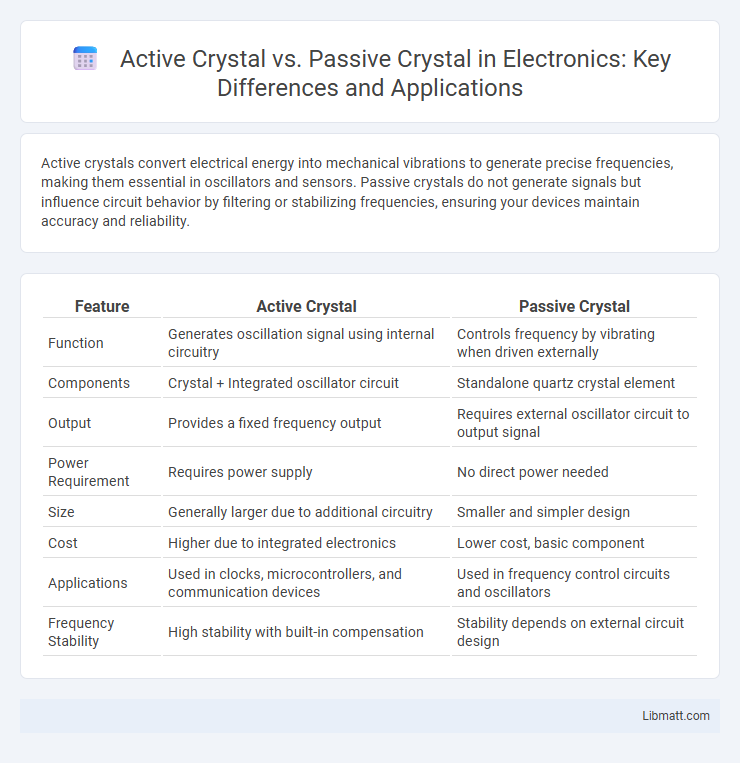Active crystals convert electrical energy into mechanical vibrations to generate precise frequencies, making them essential in oscillators and sensors. Passive crystals do not generate signals but influence circuit behavior by filtering or stabilizing frequencies, ensuring your devices maintain accuracy and reliability.
Table of Comparison
| Feature | Active Crystal | Passive Crystal |
|---|---|---|
| Function | Generates oscillation signal using internal circuitry | Controls frequency by vibrating when driven externally |
| Components | Crystal + Integrated oscillator circuit | Standalone quartz crystal element |
| Output | Provides a fixed frequency output | Requires external oscillator circuit to output signal |
| Power Requirement | Requires power supply | No direct power needed |
| Size | Generally larger due to additional circuitry | Smaller and simpler design |
| Cost | Higher due to integrated electronics | Lower cost, basic component |
| Applications | Used in clocks, microcontrollers, and communication devices | Used in frequency control circuits and oscillators |
| Frequency Stability | High stability with built-in compensation | Stability depends on external circuit design |
Introduction to Crystal Oscillators
Crystal oscillators rely on quartz crystals to generate precise frequency signals, with active crystal oscillators incorporating an internal amplifier to sustain oscillations, while passive crystal oscillators require an external circuit to drive the crystal. The stability and accuracy of frequency depend heavily on the crystal's properties and the oscillator circuit design, where active types offer better signal amplitude and frequency stability. When selecting a crystal oscillator for your application, consider whether an integrated amplification (active) or an external driving signal (passive) best suits your precision and power requirements.
Defining Active Crystals
Active crystals generate and amplify optical signals through nonlinear interactions or stimulated emission, often used in lasers and photonics for frequency conversion and signal enhancement. These crystals contain dopants like rare-earth ions or transition metals, enabling them to absorb pump energy and emit coherent light. In contrast, passive crystals simply alter the phase, polarization, or direction of light without adding energy, serving roles in modulation and nonlinear optics.
Defining Passive Crystals
Passive crystals are quartz crystals that do not generate an electrical signal but instead serve as frequency-determining components in electronic circuits. These crystals rely on external oscillators to produce vibrations, maintaining a stable frequency reference. You can identify passive crystals by their simpler structure, lacking integrated active circuitry found in active crystals.
Working Principle: Active vs. Passive Crystals
Active crystals generate and amplify electrical signals by converting electrical energy into mechanical vibrations, commonly used in oscillators and frequency control devices. Passive crystals, on the other hand, rely on their inherent piezoelectric properties to filter or stabilize signals without amplification. Understanding the working principle of active versus passive crystals helps you optimize their application in precise frequency management and signal processing.
Key Differences Between Active and Passive Crystals
Active crystals generate ultrasonic waves by converting electrical energy into mechanical vibrations, commonly used in devices like piezoelectric sensors and actuators. Passive crystals do not generate waves but respond to external forces or fields, serving primarily as filters or frequency stabilizers in electronic circuits. The key difference lies in active crystals' ability to produce energy-driven oscillations, while passive crystals function by modifying or filtering existing signals.
Performance Comparison: Stability and Accuracy
Active crystals exhibit superior frequency stability and accuracy due to their self-oscillating circuitry, enabling consistent oscillation under varying environmental conditions. Passive crystals rely on external circuitry for oscillation, which can introduce more variability and lower precision in frequency output. Performance comparisons highlight that active crystals maintain tighter frequency tolerance and reduced phase noise, making them ideal for high-precision applications.
Power Consumption and Efficiency
Active crystals consume more power due to their integrated amplifiers or oscillators, which enhance signal strength but increase energy usage. Passive crystals rely solely on external circuitry for signal generation, resulting in significantly lower power consumption and higher energy efficiency. Consequently, passive crystals are preferred in low-power applications, while active crystals suit scenarios requiring stronger signal outputs despite higher power demands.
Applications of Active Crystals
Active crystals, utilized in laser technology and nonlinear optics, amplify light through stimulated emission, enabling applications like solid-state lasers and optical amplifiers. These crystals, such as doped yttrium aluminum garnet (YAG) and lithium niobate (LiNbO3), are essential in telecommunications, medical devices, and high-precision spectroscopy. Their ability to convert and intensify light beams contributes to advanced photonic systems and laser machining processes.
Applications of Passive Crystals
Passive crystals are widely utilized in laser technology, optoelectronics, and nonlinear optics due to their stable properties and ability to modulate light without external energy input. These crystals serve as saturable absorbers for Q-switching in solid-state lasers, enhancing pulse generation and performance stability. Your choice of passive crystals significantly impacts the efficiency and precision of optical devices in telecommunications, medical lasers, and scientific instrumentation.
Choosing the Right Crystal for Your Project
Active crystals generate an electrical signal when subjected to mechanical stress, making them ideal for sensors and resonators requiring precise frequency control. Passive crystals, on the other hand, serve primarily as frequency references without generating signals themselves, suitable for stabilizing oscillators. Choosing the right crystal for your project depends on whether you need an integrated signal source (active) or a stable frequency element (passive) to ensure optimal performance.
Active Crystal vs Passive Crystal Infographic

 libmatt.com
libmatt.com